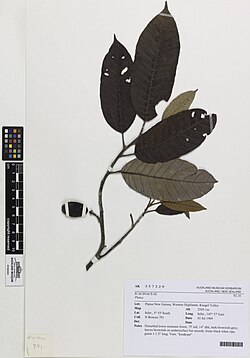Platea (plant)
 From Wikipedia - Reading time: 4 min
From Wikipedia - Reading time: 4 min
| Platea | |
|---|---|

| |
| Scientific classification | |
| Kingdom: | Plantae |
| Clade: | Tracheophytes |
| Clade: | Angiosperms |
| Clade: | Eudicots |
| Clade: | Asterids |
| Clade: | Lamiids |
| Order: | Metteniusales |
| Family: | Metteniusaceae |
| Genus: | Platea Blume |
| Type species | |
| Platea excelsa | |
Platea, known as 肖榄属 (xiao lan shu) in Mandarin,[1] is a genus in the Metteniusaceae found in tropical and subtropical Asia. It is a small genus of mostly dioecious trees that grow in high-elevation forests.[2][3][1]
Description
[edit]Platea is a genus of predominantly dioecious trees with spirally arranged leathery leaves. Plants may grow up to 45 meters tall. The young shoots and branches are covered with stellate (star-shaped) trichomes or simple hairs. The staminate (male) flowers are arranged in panicles and the pistillate (female) flowers in racemes. The flowers are pentamerous (floral parts arranged in five), with female flowers lacking petals. The stigma is sessile and disc-shaped, and the ovaries are cylindrical. The fruits are cylindrical drupes that are blue-black when ripe with a woody endocarp.[3][1]
Taxonomy and naming
[edit]Platea was once placed in the Icacinaceae. After the Icacinaceae were split into four smaller families, Platea was transferred to the Metteniusaceae. As of February 2023, it consists of 8 accepted species:[2]
- Platea bullata Sleumer
- Platea excelsa Blume
- Platea hongiaoensis Tagane
- Platea kachinensis Y.H.Tan & H.B.Ding
- Platea latifolia Blume
- Platea malayana Utteridge
- Platea parvifolia Merr. & Chun
- Platea sclerophylla Sleumer
References
[edit]- ^ a b c "Plataea". Flora of China. Vol. 11. Retrieved 19 January 2023 – via eFloras.org, Missouri Botanical Garden, St. Louis, MO & Harvard University Herbaria, Cambridge, MA.
- ^ a b "Platea". Plants of the World Online. Royal Botanic Gardens, Kew. Retrieved 2 February 2023.
- ^ a b Utteridge, Timothy M. A. (2010). "A new species of Platea (Icacinaceae) from Peninsular Malaysia: Platea malayana". Kew Bulletin. 65 (2): 345–348. Retrieved 2 February 2023.
External links
[edit] Media related to Platea at Wikimedia Commons
Media related to Platea at Wikimedia Commons
 KSF
KSF